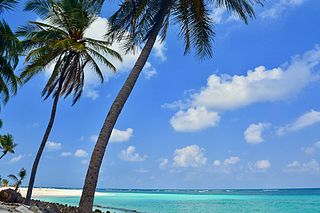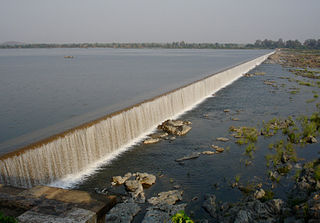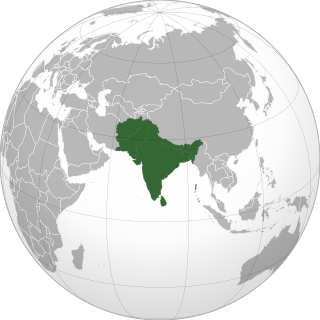 W
WSouth India is the area encompassing the Indian states of Andhra Pradesh, Karnataka, Kerala, Tamil Nadu and Telangana as well as the union territories of Lakshadweep and Puducherry, occupying 19.31% of India's area. Covering the southern part of the peninsular Deccan Plateau, South India is bounded by the Bay of Bengal in the east, the Arabian Sea in the west and the Indian Ocean in the south. The geography of the region is diverse with two mountain ranges - the Western and Eastern Ghats, bordering the plateau heartland. Godavari, Krishna, Kaveri, Tungabhadra and Vaigai rivers are important non-perennial sources of water.
 W
WAndhra Pradesh is a state in the south-eastern coastal region of India. It is the seventh-largest state by area covering an area of 162,975 km2 (62,925 sq mi) and tenth-most populous state with 49,386,799 inhabitants. It is bordered by Telangana to the north-west, Chhattisgarh to the north, Odisha to the north-east, Tamil Nadu to the south, Karnataka to the west and the Bay of Bengal to the east. It has the second longest coastline in India after Gujarat, of about 974 km (605 mi). Andhra Pradesh is the first state to be formed on a linguistic basis in India on 1 October 1953. Andhra Pradesh was once a major Buddhist pilgrimage site in India and a Buddhist learning center which can be seen in many sites in the state in the form of ruins, chaityas and stupas Andhra Pradesh is also known as the land of the world-famous diamond Koh-i-Noor and many other global known diamonds due to their presence in its Kollur Mine once. It is also known as the "rice bowl of India" for being a major producer of rice in India. Its official language is Telugu; one of the classical languages of India, the fourth most spoken language in India and the 11th-most spoken language in the world.
 W
WKarnataka is a state in the south western region of India. It is the largest state in South India and seventh largest in India. It was formed on 1 November 1956, with the passage of the States Reorganisation Act. Originally known as the State of Mysore, it was renamed Karnataka in 1973. The state corresponds to the Carnatic region. The capital and largest city is Bangalore.
 W
WKerala is a state on the southwestern Malabar Coast of India. It was formed on 1 November 1956, following the passage of the States Reorganisation Act, by combining Malayalam-speaking regions of the erstwhile states of Travancore-Cochin and Madras. Spread over 38,863 km2 (15,005 sq mi), Kerala is the twenty-first largest Indian state by area. It is bordered by Karnataka to the north and northeast, Tamil Nadu to the east and south, and the Lakshadweep Sea to the west. With 33,387,677 inhabitants as per the 2011 Census, Kerala is the thirteenth-largest Indian state by population. It is divided into 14 districts with the capital being Thiruvananthapuram. Malayalam is the most widely spoken language and is also the official language of the state.
 W
WLakshadweep is a group of islands in the Lakshadweep Sea, 200 to 440 km off the southwestern coast of India. The archipelago is administered as a union territory and district of India. They were also known as the Laccadive Islands, although geographically this is only the name of the central subgroup of the group. Lakshadweep means "one hundred thousand islands" in Sanskrit, Marathi and Malayalam. The islands form the smallest Union Territory of India and their total surface area is just 32 km2 (12 sq mi). The lagoon area covers about 4,200 km2 (1,600 sq mi), the territorial waters area 20,000 km2 (7,700 sq mi) and the exclusive economic zone area 400,000 km2 (150,000 sq mi). The region forms a single Indian district with 10 subdivisions. Kavaratti serves as the capital of the Union Territory and the region comes under the jurisdiction of Kerala High Court. The islands are the northernmost of the Lakshadweep-Maldives-Chagos group of islands, which are the tops of a vast undersea mountain range, the Chagos-Lakshadweep Ridge.
 W
WPuducherry, also known as Pondicherry, is one of the 8 union territories of India. It was formed out of four territories of former French India, namely Pondichéry, Karikal (Karaikal), Mahé and Yanaon (Yanam), excluding Chandannagar. It is named after the largest district, Puducherry. Historically known as Pondicherry, the territory changed its official name to Puducherry on 20 September 2006.
 W
WBharatanatyam, also previously called Sadira Attam, is a major form of Indian classical dance that is indigenous to Tamil Nadu. Bharatanatyam is one of the oldest classical dance traditions in India. It was nurtured in the temples and courts of southern India since ancient times It is one of eight forms of dance recognized by the Sangeet Natak Akademi and it expresses South Indian religious themes and spiritual ideas, particularly of Shaivism, Vaishnavism and Shaktism.
 W
WCarnatic music, known as Karnāṭaka saṃgīta or Karnāṭaka saṅgītam in the South Indian languages, is a system of music commonly associated with South India, including the modern Indian states of Karnataka, Andhra Pradesh, Telangana, Kerala and Tamil Nadu, and Sri Lanka. It is one of two main subgenres of Indian classical music that evolved from ancient Sanatana dharma sciences and traditions, the other subgenre being Hindustani music, which emerged as a distinct form because of Persian or Islamic influences from Northern India. The main emphasis in Carnatic music is on vocal music; most compositions are written to be sung, and even when played on instruments, they are meant to be performed in gāyaki (singing) style. The heptatonic scale is known to have its origins in Carnatic music, and later having been picked up by Pythagoras during his visit to India to learn mathematics, thus introducing it to the west. The circle of fifths and several other popular concepts in western classical music have their origins in the theory of Carnatic classical music.
 W
WThe Coastline of Andhra Pradesh is located on the southeast coast of Indian Peninsula, and forms a part of Northern Circars, with waters of Bay of Bengal. It has the third longest coastline with a length of 975 km (606 mi), next to Gujarat. The coastal corridor consists of several ports, harbours, vast stretches of sandy beaches, wildlife and bird sanctuaries, fresh water lakes, estuaries etc.
 W
WThe Coromandel Coast is the southeastern coast region of the Indian subcontinent, bounded by the Utkal Plains to the north, the Bay of Bengal to the east, the Kaveri delta to the south, and the Eastern Ghats to the west, extending over an area of about 22,800 square kilometres. Its definition can also include the northwestern coast of the island of Sri Lanka. The coast has an average elevation of 80 metres and is backed by the Eastern Ghats, a chain of low, flat-topped hills.
 W
WSouth Indian cuisine includes the cuisines of the five southern states of India—Andhra Pradesh, Karnataka, Kerala, Tamil Nadu and Telangana—and the union territories of Lakshadweep, Pondicherry, and the Andaman and Nicobar Islands.There are typically vegetarian and non-vegetarian dishes for all five states. Additionally, all regions have typical main dishes, snacks, light meals, desserts, and drinks that are well known in their respective region.
 W
WDravidian architecture or the South Indian temple style is an architectural idiom in Hindu temple architecture that emerged in the southern part of the Indian subcontinent or South India and in Sri Lanka, reaching its final form by the sixteenth century. It is seen in Hindu temples, and the most distinctive difference from north Indian styles is the use of a shorter and more pyramidal tower over the garbhagriha or sanctuary called a vimana, where the north has taller towers, usually bending inwards as they rise, called shikharas. However, for modern visitors to larger temples the dominating feature is the high gopura or gatehouse at the edge of the compound; large temples have several, dwarfing the vimana; these are a much more recent development. There are numerous other distinct features.
 W
WThe Geography of South India comprises the diverse topological and climatic patterns of South India. South India is a peninsula in the shape of a vast inverted triangle, bounded on the west by the Arabian Sea, on the east by the Bay of Bengal and on the north by the Vindhya and Satpura ranges. Technically all Indian territories below the 20th Parallel.
 W
WThe Godavari is India's second longest river after the Ganga. Its source is in Triambakeshwar, Maharashtra. It flows east for 1,465 kilometres (910 mi), draining the states of Maharashtra (48.6%), Telangana (18.8%), Andhra Pradesh (4.5%), Chhattisgarh (10.9%) and Odisha (5.7%). The river ultimately empties into the Bay of Bengal through an extensive network of tributaries. Measuring up to 312,812 km2 (120,777 sq mi), it forms one of the largest river basins in the Indian subcontinent, with only the Ganga and Indus rivers having a larger drainage basin. In terms of length, catchment area and discharge, the Godavari is the largest in peninsular India, and had been dubbed as the Dakshin Ganga.
 W
WThe history of southern India covers a span of over four thousand years during which the region saw the rise and fall of a number of dynasties and empires. The period of known history of the region begins with the Iron Age period until the 15th century CE. Dynasties of Chera, Chola, Pandyan, Chalukya, Pallava, Satavahana Rashtrakuta, Kakatiya, Reddy dynasty, Seuna (Yadava) dynasty and Hoysala were at their peak during various periods of history. These Dynasties constantly fought amongst each other and against external forces when northern armies invaded southern India. Vijayanagara empire rose in response to the Muslim intervention and covered the most of southern India and acted as a bulwark against Mughal expansion into the south. When the European powers arrived during the 16th and 18th century CE, the southern kingdoms, most notably Tipu Sultan's Kingdom of Mysore, resisted the new threats, and many parts eventually succumbed to British occupation. The British created the Madras Presidency which acted as an administrative centre for the rest of South India, with them being princely states. After Indian independence South India was linguistically divided into the states of Tamil Nadu, Andhra Pradesh, Karnataka, Telangana and Kerala.
 W
WA History of South India: From Prehistoric Times to the Fall of Vijayanagar is a book of history written by Indian historian K. A. Nilakanta Sastri. First published as a book in 1955, revised editions were brought out in 1958, 1966 and the last, just before the author's death in 1975. A History of South India is widely recognized as a classic and was the standard textbook in colleges for teaching South Indian history for over four decades.
 W
WA katcheri is an assembly of musicians and audience in the context of Carnatic music or Karnatick music. It is presented in the concert format. The music fraternity of connoisseurs and common people assemble at the katcheri venues to listen to classical music concerts of vidwans. Etymologically the word "katcheri" is derived from Urdu language and in Hindi to mean a court of law.
 W
WPolitics in South India is typically dominated by regional parties than by the larger national political parties such as the Congress (INC) or BJP (BJP). However, both the BJP and INC have had some success in forging alliances with regional parties. Unlike in North India, where religion plays an important role in driving local politics, South India's political issues of contention are mainly caste, language and ethnicity.
 W
WSouth Indian International Movie Awards, also known as the SIIMA Awards, rewards the artistic and technical achievements of the South Indian film industry.
 W
WTamil Nadu is one of the 28 states of India. Its capital and largest city is Chennai. Tamil Nadu lies in the southernmost part of the Indian subcontinent and is bordered by the union territory of Puducherry and the South Indian states of Kerala, Karnataka, and Andhra Pradesh. It is bounded by the Eastern Ghats on the north, by the Nilgiri Mountains, the Meghamalai Hills, and Kerala on the west, by the Bay of Bengal in the east, by the Gulf of Mannar and the Palk Strait on the southeast, and by the Indian Ocean on the south. The state shares a maritime border with the nation of Sri Lanka.
 W
WVaddanam is a gold ornamental belt worn by South Indian women on special occasions.